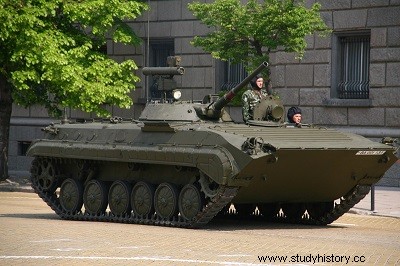
BMP- 1
Type :motorized infantry fighting vehicle.
Crew :3 + 8 men.
Armament :a 73 mm gun; a coaxial 7.62mm PKT machine gun; a launch pad for the ATGW “Sagger” anti-tank missile.
Armour:
maximum 14mm.
Dimensions:
length: 6.30m;
width: 3.05 m;
height :1.83 m.
Weight in combat order: 12 t
Ground pressure:0.57 kg/crn2.
Specific power :22.7 bhp.
Engine: Model V-6 6 cyl. in-line water-cooled diesel, developing 284 hp at 2,000 rpm.
Performance:
road speed speed:60 km/h;
speed on water speed:8 km/h;
range :500 km;
vertical obstacle :1.10 m;
clean cut :1.98 m;
slope :60%.
Service time :introduced in 1967. Used by East Germany Egypt, Iraq, Libya, Poland, Syria, Czechoslovakia, Soviet Union.
The Soviet BMP-1 was the very first motorized infantry fighting vehicle in the world. Previously, some armies used the armored personnel carrier (such as the American M113) to bring their infantry to the battlefield. Arrived on the spot, the soldiers left the vehicle to fight on foot. The motorized infantry fighting vehicle has the advantage of allowing infantrymen to use their weapons without leaving the vehicle since it is equipped with firing hatches both on the sides and at the rear. In addition, more powerfully armed than the standard troop carrier, it can tackle light armor as well as infantry. Introduced into the Soviet army in 1967, the BMP-1 has since been exported to several countries including Egypt and Syria which used it during the Yom Kippur War in 1973.
The hull is an all wrought steel assembly. The driver is at the front on the left, the commander behind him and the engine on his right. The turret is in the center of the vehicle, the troop compartment in the back. The eight infantrymen access the vehicle through a double rear door whose leaves contain a reserve of fuel. In addition, there are four hatches above the troop compartment.
The turret of the BMP- 1 also equips the new BMD vehicle (next section) It is armed with a 73 mm smoothbore cannon fed by a magazine of 30 shells. The gun fires the HEAT projectile or the stabilizer fin HE; its maximum real range is 1,500 m.
The turret allows 360° firing in azimuth and the gun offers firing in elevation from 5° to +20° A 7.62 mm machine gun is twinned with the gun The ammunition load for this weapon is 1,000 cartridges. A launch pad for the AT-3 “Sagger ATGW” anti-tank missile is mounted on the barrel. This missile has a maximum range of 3,000 m; the BMP-1 carries five “Saggers”.
In addition to the infantrymen's AKMS rifles and light machine gun, there is also an SA-7 “Grail” surface-to-air missile (SAM) on board for close air defense. Completely amphibious, the BMP-1 is propelled on water by its tracks. Like most modern vehicles, it has an NBC system that allows it to operate in a contaminated area. It has full night vision equipment, including infrared driving lights and infrared searchlights for the commander and gunner.
The BMP-1 was designed to operate in conjunction with the T-62 main battle tank to form a tank-infantry team. When needed, however, it can act independently as it is the most powerfully armed motorized infantry fighting vehicle available. But, within the Soviet army, the role that the BMP-1 could actually play on the battlefield is very controversial.
